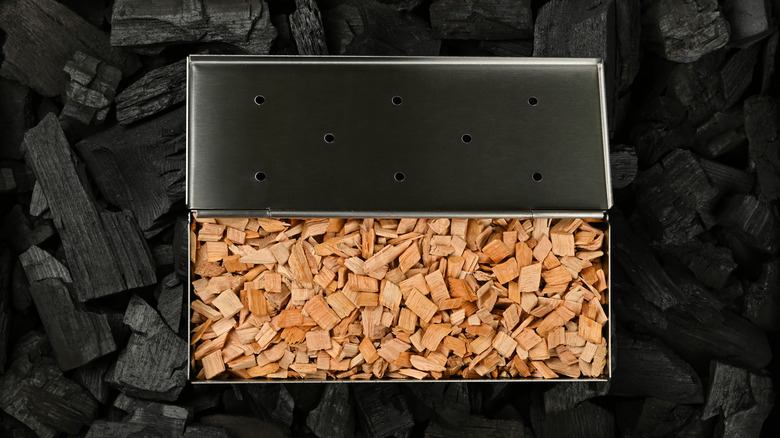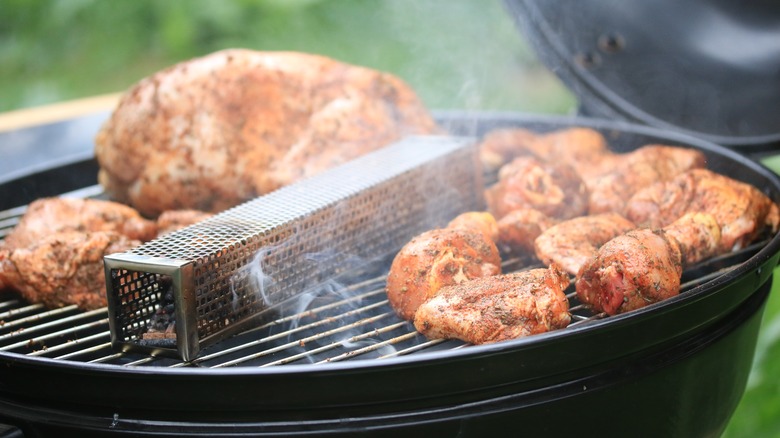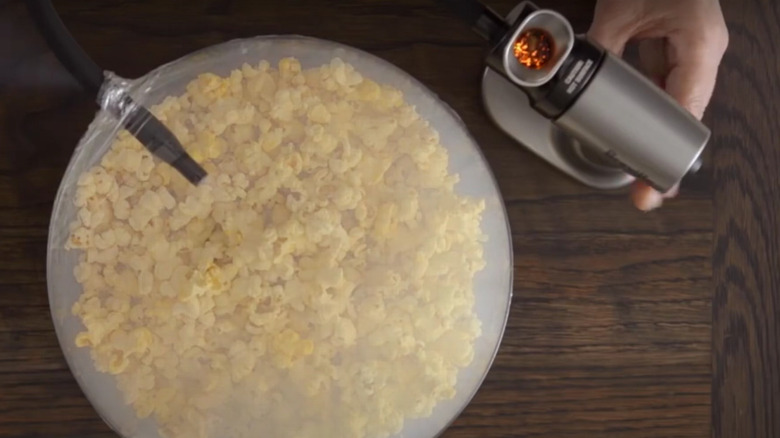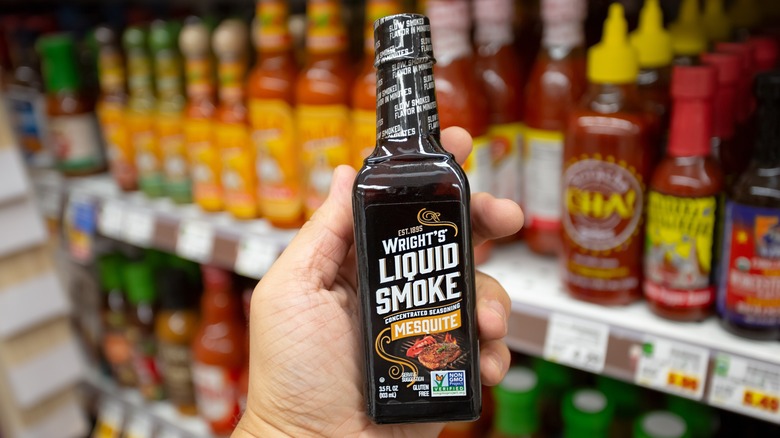3 Ways To Create The Flavor Of Smoked Meat Without A Smoker
We may receive a commission on purchases made from links.
For barbecue aficionados, creating delicious smoky flavor in steaks or chicken sans smoker can be as easy as one, two, three. Chowhound spoke with Rich Parente, chef and owner of farm-to-table restaurant Clock Tower Grill in Brewster, New York, about these three infusion options. They include a smoker box, a smoking gun, and liquid smoke. Each of these options is fairly simple, if not downright easy, to employ and comes with its own advantages and disadvantages. Although, as Parente cautions, "Be careful when cooking with liquid smoke — use it sparingly, as a couple drops of it goes a long way."
For those who already have a gas grill on the back patio but no smoker, it makes sense to start your flavor research process with the most troublesome but effective method: a smoker box, like this stainless steel model from Weber. In this set-up, the smoke flavor doesn't arise from the briquettes, as it would with a charcoal grill or a smoker, or a condiment like liquid smoke.
Instead, it comes from the combination of the gas grill and the smoker box. "Fill the box with wood chips, set it on the grill grates and let it fill the grill with smoke to add that smoky flavor to meats," Parente advises. The wood chunks or chips are ignited and left to burn inside the box. The resulting smoke flows through its holes (often on the top and sides) to infuse your food with flavor. Wood chips for smoking and grilling come in various flavors, like this apple, hickory, and mesquite bundle from Mr. Bar-B-Q. Some advanced grill masters mix the chips to create more complex flavors in their meats and veggies.
Working with a smoker box
To get started with a smoker box, fire up your gas grill and allow it to heat up on high for 10 to 15 minutes. Fill the box with wood chips, but be mindful that there's a sweet spot for how many you should put inside. You don't want to overfill the box, because this could restrict airflow. On the other hand, you want the chips to be close enough to each other to keep the flame lit.
Once you've loaded the box with chips, place it over a direct source of heat, either on top of the grill's grates or one of the burners. The advantage of doing the latter is that it takes up less real estate on the grill, so if you're cooking a few New York strips or Ribeye steaks, you won't run into the issue of overcrowding your grill. In all cases, be sure to start with uncooked meat. This allows the smoke to seep deeply into the meat as it cooks, making for a stronger, smokier flavor. If conditions permit, let the meat smoke for 20 to 30 minutes.
To ensure that the flame takes, leave the lid of the box open for a few minutes. This gives the smoking wood chips access to more air. Often, the wood chunks ignite from the high heat of the gas grill. However, if they're reluctant to catch fire, don't hesitate to use a tool, like Jo Chef's refillable butane kitchen torch, to get the flames going. Once they are, place the box over a strong heat source to keep the smoke coming and infusing your food with flavor.
Get grilled flavor with a smoking gun
As for smoking foods without a grill, chef Rich Parente suggests using a smoking gun to infuse a dish with flavor after it's finished cooking. Fortunately, it's an easy tool to master — and it's remarkably versatile. Basically, operating a smoking gun (like this model from Breville) is akin to stuffing tobacco into a pipe. At the tip of the gun there's a hole, which accommodates a separate mesh chamber. This chamber is where you'll stuff and light a small amount of wood chips.
The base of the gun requires batteries, which run the fan that creates airflow in the machine. Somewhere on the tool there should be a second hole, where you connect the smoke hose, which allows you to direct the smoke at the food inside a smoke chamber you've created. A bowl or tray covered with plastic wrap (ideally frozen to prevent it from sticking to itself) works well for this. Whatever you use, you'll want to leave a small gap between the container and its covering to feed the hose through.
Using this machine is simpler than using a smoker box in some ways, because the only "live" fire comes from the smoldering wood chips in the small mesh chamber. The fan keeps the wood smoking for the duration of your infusion time, which is usually just a couple of minutes. What's really great about this tool is that you have the option of smoking some unusual items, like ice cream, cheese, and popcorn. You can even make smoked cocktails with it.
Tips for using liquid smoke effectively
If you've ever had an experience that made you exclaim, "I wish that I could bottle this up and keep it," then you'll appreciate the concept of liquid smoke. This flavor-packed product is created by burning wood chips and condensing smoke's "steamy" vapors into a liquid, which is eventually bottled and sold on store shelves. You'll locate it in the same aisle you find condiments like barbecue sauce, but various options are also available online, such as Stubb's hickory liquid smoke.
However, unlike other condiments, it's best to use liquid smoke before the cooking process commences instead of when it's complete. To heed chef Rich Parente's warning about not using too much, keep the less-is-more model in mind. You'll only need about a 1/4 or 1/2 teaspoon of liquid smoke to flavor grillable foods. When you're working with ground meat, it's okay to just mix the liquid smoke into the meat with your hands. For whole meats, like chicken breasts or pork chops, and veggies, use a coating of olive first. Then, rub the liquid smoke onto the food. Additional seasonings come after this.
Liquid smoke is a remarkably affordable and easy way to infuse smoky flavor into meat, but its taste may not have the same complexity as burning different types of wood chips of your choosing. Regardless of whichever of these three flavoring methods you use, though, your food will taste like you're a barbecue master, even if the smoke came from a special tool or a bottle instead of a charcoal grill or a dedicated smoker.



